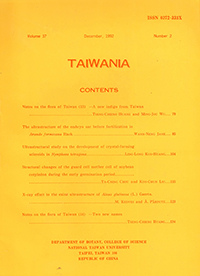Research Paper
Ultrastructural study on the development of crystal-forming sclereids in Nymphaea tetragona
Ling-Long Kuo-Huang
Published on: June 1992
Page: 104 - 114
DOI: 10.6165/tai.1992.37.104
Abstract
The sclereids of Nymphaea tetragona Georgi originate sporadically from the fundamental parenchyma. They undergo the following developmental phases: (1) phase of hypertrophic growth and ramification; (2) phase of crystal formation; and (3) Phase of the sclerification. The distinguishable features of sclereid initials are their large nucleus, dense cytoplasm with abundant organelles and the conspicuous branching of the cells. The formation of calcium oxalate crystals in the cell wall of developing sclereid generally occurs after its shape is attained. Between the plasmalemma and the primary cell wall many crystal chambers are formed, which are bounded by crystal sheath. Mitochondria, dictyosomes, and endoplasmic reticulum often occur in close association with the plasmalemma surrounding the crystal chambers. At maturity, the sclereids posses extremely thick walls and the crystals are embedded between the primary and secondary wall. In plant cells the calcium oxalate crystals are generally located in the central vacuoles.
中文摘要
睡蓮厚壁細胞分散地起源於基本組織的薄壁細胞,其發育過程可分為:(1)細胞增大與分枝化期;(2)結晶體形成期;以及(3)厚壁化期。厚壁起源細胞的特徵為大的核、濃細胞質、與明顯的分枝。通常當後壁起源細胞達到成熟形態,不在行頂端浸入生長時,其細胞壁便開始形成草酸鈣結晶體。許多結晶腔分散的形成於細胞膜與初生細胞壁之間,結晶腔外覆結晶鞘,而細胞質內的粒腺體、高網體、及內網體與結晶腔臨近之細胞膜密切相關。成熟的厚壁細胞具有很厚的細胞壁,結晶體存在於初生細胞壁與次生細胞壁之間,此與一般植物之草酸鈣晶體存在於液胞內之情況不同。


